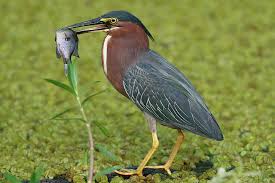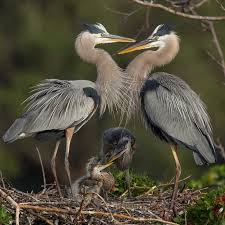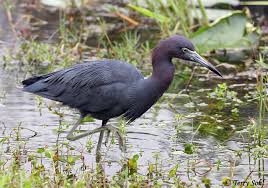By BA Nester

Here come the Herons of North America: The Tricolored Heron, the Green Heron, the Great Blue Heron, the Little Blue Heron, the Yellow-crowned Night-heron and the Black-crowned Night-heron.
The first 4, the TriColored, Green, Great Blue and Little Blue are all colony nesters who build their nests primarily out of sticks. The Yellow-crowned and Black-crowned primarily build their nests in reed-beds. Any group of herons living or nesting together is called a “Siege” of Herons. I’ll bet anyone who has a stocked fish pond would agree with THAT name!

Tricolored Heron
This is the perfect description directly quoted from All About Birds: “The Tricolored Heron is a sleek and slender heron adorned in blue-gray, lavender, and white. The white stripe down the middle of its sinuous neck and its white belly set it apart from other dark herons. This fairly small heron wades through coastal waters in search of small fish, often running and stopping with quick turns and starts, as if dancing in a ballet.”
These beauties live in the southern coastal marshes. I have been fortunate enough to have lived in an environment where we could watch them fishing from our dock. The Cornell Lab describes their movements as a “ballet”. Our neighbors called them the “drunk birds” as they looked like they were reeling about. Their atypical style of hunting makes them easy to differentiate from the other herons. Just remember, the Dancing or Drunk herons are the Tricolors! Typical to many birds, the Tricolored can be an oportunistic feeder, following following cormorants or grebes and snapping up the fish the other guys stir up!

Green Heron
“From a distance, the Green Heron is a dark, stocky bird hunched on slender yellow legs at the water’s edge, often hidden behind a tangle of leaves. Seen up close, it is a striking bird with a velvet-green back, rich chestnut body, and a dark cap often raised into a short crest. These small herons crouch patiently to surprise fish with a snatch of their daggerlike bill. They sometimes lure in fish using small items such as twigs or insects as bait.” * This practice makes the Green Heron one just a few birds worldwide which use tools to catch their prey! If you want to see these beautiful herons, take your patience along with your binocs and park yourself so you can see the edges of the marsh, then watch for movement. Look for a hunched-up bird about the size of a crow with a long, straight bill, staring intently at the water. There he is, the beautiful Green Heron!

Great Blue Heron
This is the one everyone recognizes, the archetype HERON! Tall! Stately! Standing perfectly still in the water, his beautiful blue-gray feathers ruffling in the wind, staring intently at the water! Then, ZOOM! With lightning speed it strikes and pierces a fish or crayfish or, if he’s in a meadow, a chipmunk! Here in NE Forida I have watched them stalk the anoles and chameleons and little Black Racer snakes with the same intense look and speedy stabbing.
The Great Blues are the tallest of all North American herons, but, interestingly, like all birds with their hollow bones, they weigh very little. Would you believe 5 or 6 pounds? Yes!
Great Blues fly with a strong and steady wingbeat casting a mighty big shadow as they fly overhead. Their necks are curved back in an S-shape and their long legs are trailing behind. I love watching them “back-wing” as they land in the water! One thing I have never gotten used to, however, is seeing them land in the tall slash pines and stand there like an owl! Silly looking!

Little Blue Heron
“A small, dark heron arrayed in moody blues and purples, the Little Blue Heron is a common but inconspicuous resident of marshes and estuaries in the Southeast. They stalk shallow waters for small fish and amphibians, adopting a quiet, methodical approach that can make these gorgeous herons surprisingly easy to overlook.” * The Little Blue is smaller than the Great Blue, but bigger than a crow. They look like a “dark heron” when you see them without direct light, when their pretty maroon head and neck shows up. I used to pay attention to their leg color and bill color when differentiating them from the Reddish Egret. The Little Blue has greenish legs and a bill that is pale blue with a black tip. The Reddish Egret has gray legs and their bills are pink with a black tip. While the Reddish Egret is a bigger bird, when you see them in the field, scale is sometimes difficult.
The Little Blue Herons are patient. They stand still, waiting for their prey to swim or float by, rather than dashing about like the Tricolored. If they don’t find anything, they will fly off to a completely new spot. So, again, when you are looking for them, scan the edges of the water and look for a still figure, watching and waiting!

Yellow-crowned Night-heron
“While not as slender as a typical heron, the Yellow-crowned Night-Heron’s smooth purple-gray colors, sharp black-and-white face, and long yellow plumes lend it a touch of elegance. They forage at all hours of the day and night, stalking crustaceans in shallow wetlands and wet fields. Their diet leans heavily on crabs and crayfish, which they catch with a lunge and shake apart, or swallow whole. They’re most common in coastal marshes, barrier islands, and mangroves, but their range extends inland as far as the Midwest.” *
I love the Night-herons. We used to watch them sit on the pilings at dusk, especially at low-tide when they could spot some tasty crabs! If you are scanning the reed-beds, watch for the adults’ elegant yellow and black head to pop up! They aren’t only coastal birds. You can find them on golf courses and further inland along wooded river valleys. Keep your eyes open at dusk and dawn to spot them! Or listen for their harsh SQUAWK before the settle in!

Black-crowned Night-heron
I love this description of the Black-crowned from Arthur Bent’s Life Histories of North American Marsh Birds: “How often, in the gathering dusk of evening, have we heard its loud, choking squawk and, looking up, have seen its stocky form, dimly outlined against the gray sky and propelled by steady wing beats, as it wings its way high in the air toward its evening feeding place in some distant pond or marsh!” Perfect description of this night feeding heron!
The Black-crowned’s territory covers most of the US, Mexico and Central America. A common bird, but once again, harder to see because unless you are out at dusk or dawn, you will probably miss them! They are social birds and will roost with other herons and egrets. I always looked for their white chest and red-eyes to make my ID! I love the jaunty little, white head-plume they get during breeding season!
Well, there you have it, the 6 species of Herons of North America! Social nesters, loud, aquatic-feeding, squawky, diverse and beautiful HERONS!
* From the Cornell Lab’s All About Birds